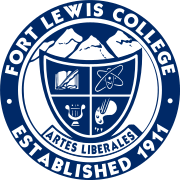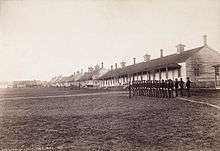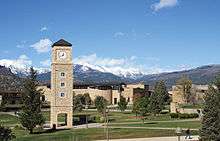Fort Lewis College
Fort Lewis College[3] is a public liberal arts college in Durango, Colorado.
 | |
| Type | Public liberal arts college |
|---|---|
| Established | 1911[1] |
| Provost | Cheryl Nixon |
| Undergraduates | 3,864 [1] |
| Location | , , United States 37.275°N 107.869999°W |
| Colors | Dark blue, Light blue, Gold [2] |
| Athletics | NCAA Division II – Rocky Mountain |
| Nickname | Skyhawks |
| Affiliations | Council of Public Liberal Arts Colleges |
| Sports | Varsity, club, and intramural |
| Mascot | Skyler the Skyhawk |
| Website | www |
 | |
Because of its unique origins as a military fort turned Indian boarding school turned state public school, Fort Lewis College follows a 1911 mandate to provide a tuition-free education for qualified Native Americans, and awards approximately 16% of the baccalaureate degrees earned by Native American students in the nation. In 2008, the U.S. Department of Education designated FLC as one of six Native American-serving, non-tribal colleges.[4]
FLC is a member of the Council of Public Liberal Arts Colleges and is accredited by the Higher Learning Commission, with additional program-level accreditations in accounting, business administration, economics, marketing, athletic training, chemistry, engineering, physics, music, and teacher education. The college offers 30 bachelor's degrees through its four academic units.
History
The first Fort Lewis army post was constructed in Pagosa Springs, Colorado, in 1878, and was relocated in 1880 to Hesperus, Colorado, on the southern slopes of the La Plata Mountains. In 1891, Fort Lewis was decommissioned and converted into a federal, off-reservation Indian boarding school.
In 1911, the fort's property and buildings in Hesperus were transferred to the state of Colorado to establish an "agricultural and mechanic arts high school." That deed came with two conditions: that the land would be used for an educational institution, and “to be maintained as an institution of learning to which Indian students will be admitted free of tuition and on an equality with white students” in perpetuity (Act of 61st Congress, 1911). Both conditions have been the missions and guides for the Fort Lewis school's various incarnations over the past century.
In the 1930s, the Fort Lewis high school expanded into a two-year college, and in 1948 became Fort Lewis A&M College, under control of State Board of Agriculture. The "Aggies" studying at the Fort Lewis Branch of the Colorado State College of Agriculture and Mechanics could choose from courses including agriculture, forestry, engineering, veterinary science, and home economics.

Fort Lewis College underwent another period of growth and changes starting in 1956, when the college moved from its long-time home in Hesperus to its present location, 18 miles east, atop what was then known as Reservoir Hill, overlooking Durango. Here, FLC became a four-year institution, awarding its first baccalaureate degrees in 1964.
Also in 1964, the college dropped the "A&M" moniker. At that time, the new Fort Lewis College also changed its mascot from "Aggies" to the "Raiders," and changed the school's colors from the green and yellow of the Colorado State University system it had been affiliated with to the blue and gold it still sports today.[5]
In recent history: In 1994, the college's mascot became the Skyhawks, retaining the blue and gold. In 1995, Fort Lewis College joined the Council of Public Liberal Arts Colleges, and in 2002, the College became independent of the Colorado State University system, and formed its own governing Board of Trustees.
Campus
The 247-acre Fort Lewis College campus is in southwestern Colorado is situated at 6,872 feet atop a mesa overlooking the Animas River Valley and downtown Durango. A network of trails as well as city bus service (free to students with FLC IDs) connects the campus and town.
The campus' distinctive architectural theme utilizes locally quarried sandstone to acknowledge the region's Native puebloan building style and evoke the Four Corners landscape and colors. The style was crafted by prominent Boulder architect James M. Hunter, who was contracted to establish a campus building plan by the college in the late 1950s, following the college's move from Hesperus, Colorado, to its Durango location.
Today, on-campus housing is in six residence halls and two apartment buildings, with singles, doubles, and suites. Also on campus are 14 academic buildings, as well as a Student Life Center, Aquatic Center, and Student Union. On-campus athletic facilities include Ray Dennison Memorial Field, Dirks Field, the Softball Complex, Whalen Gymnasium, and the Factory Trails, an off-road bicycling race course.

The new Student Union opened in Fall 2011, and now hosts the college's cultural centers, the Native American Center and El Centro de Muchos Colores, as well as student government, the Environmental Center, the post office, and the bookstore. The new Student Union also offers several dining options, and houses both a Leadership Center and a Media Center that includes the college's news magazine, literary journal, and KDUR radio station.
The Student Union building was awarded LEED Gold status in August by the U.S. Green Building Council for its sustainability features. It is the third LEED Gold building on campus, along with the Berndt Hall Biology Wing and the residential Animas Hall. Those environmental awards helped FLC be named one of "America's Coolest Schools" by Sierra magazine, the official publication of the Sierra Club, in 2011.[6]
Academics
Fort Lewis College is divided into four academic units, offering 32 baccalaureate degrees.[7] Programs are accredited by the Higher Learning Commission, the Accreditation Board for Engineering & Technology, the American Chemical Society, the Association to Advance Collegiate Schools of Business, the Commission on Accreditation of Athletic Training Education, and the National Association of Schools of Music.
Athletics
The college's athletic teams, nicknamed the Skyhawks, compete in the NCAA at the Division II level as a member of the Rocky Mountain Athletic Conference (RMAC); as well as the Western Intercollegiate Lacrosse Association (WILA) for women's lacrosse and a nationally ranked cycling program that competes at the Division I level of USA Collegiate Cycling.[8] In 2017, Fort Lewis' cycling program won its 23rd national championship with an overall victory at the 2017 USA Cycling Collegiate Mountain Bike National Championships in Missoula, Montana.[9]
|
Men's sports
|
Women's sports
|
Notable alumni
- David M. Beazley – Python developer and author
- Chris Camozzi (attended) – competed in wrestling and rugby; professional mixed martial artist[10]
- Nicco Montaño[11] – professional Mixed Martial Artist, inaugural and current UFC Flyweight Champion.[12] First UFC Champion with Navajo descent.[13]
- Brianne Nelson – distance runner
- Scott Stamper – running back for the San Antonio Gunslingers in the USFL[14][15]
- Scott Tipton – United States House of Representatives (CO-3 R)
References
- "Fort Lewis College (2011)". U.S. News and World Report. Retrieved 2012-02-23.
- https://www.fortlewis.edu/Portals/119/Docs/flcguide2.pdf
- "Fort Lewis College | Durango, Colorado". fortlewis.edu. Retrieved 2019-11-04.
- National Science Foundation, WebCASPAR 2009
- Smith, Duane (1991). Sacred Trust: The birth and development of Fort Lewis College. University Press of Colorado. ISBN 978-0-87081-234-7.
- Sierra "Cool Schools 2011"
- https://www.fortlewis.edu/majorsandprograms/UndergraduateMajorsandPrograms.aspx
- Meyer, Matt (October 6, 2012). "Mavericks modeling cycling program after Fort Lewis". Gran Junction Sentinel. Retrieved January 20, 2013.
- Livingston, John. "Fort Lewis College cycling claims 23rd national championship". The Durango Herald (23 October 2017). Ballantine Communications. Retrieved 19 December 2017.
- "Chris Camozzi UFC Bio". Retrieved 2014-01-01.
- "Archived copy". Archived from the original on 2018-07-22. Retrieved 2018-07-24.CS1 maint: archived copy as title (link)
- http://www.ufc.com/fighter/Nicco-Montano
- https://www.nhonews.com/news/2018/jan/30/navajo-nation-honors-ufc-champion-nicco-montano/
- Langford, Mark (March 23, 1984). "When the USFL San Antonio Gunslingers and the Oakland..." UPI. Retrieved January 19, 2016.
- "Transactions". The New York Times. February 2, 1983. Retrieved January 19, 2016.